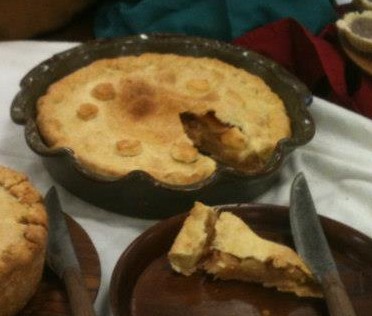Introduction:
The final dish of the first course of the Taming of the Shrew event – the menus called for buttery cakes, but I wanted a carb in this course that could be eaten by all guests, including vegans. One of the richest vegan breads I could think of was foccacia – and conviently, while Scappi doesn’t provide a recipe for it, he does mention it in recipe 142, book VI of the Opera.
Discussion
- According to Fiorenzo Toso, modern linguist and author of the “Little Ligurian Dictionary”, the word fugassa (a term in the Genoese dialect of fogaccia) appears for the first time in a document written in 1300, so this type of bread had a history in northern Italy well before Scappi’s career. (
- The defining feature of foccacia is the heavy inclusion of olive oil, both in the dough and as a topping (along with other flavorings, in this case salt but in others garlic, rosemary and other herbs, or even rendered pork cracklings). It’s also a high-hydration dough, which is improved by reducing the yeast and allowing a longer, slower rise time, if possible.
Focaccia
Servings
40
servingsIngredients
4kg bread flour
80-100g salt
4 packets yeast (each 2.25 tsp)
12 oz olive oil (divided)
Directions
- Mix flour, salt, and yeast. Add 12tbs olive oil. Add lukewarm (about 100°F – 110°F) water to form a fairly slack dough – hydration should be around 80% so about 800g water per kg of flour. It will be sticky.
- Rest at room temperature for at least an hour.
- Transfer dough to a clean floured surface. Stretch and fold using the following procedure: Pat into rectangle. Fold two edges to the center and seal. Fold other two edges to center and seal. Fold first two edges to center again and seal.
- Rest dough for 15 minutes.
- Repeat stretch and fold process with rested dough.
- First rise: allow to rise for 18 hours or more in the refrigerator, or 1-2 hours at room temperature. Dough will double in size.
- (If refrigerated, allow dough to come to room temperature.) Deflate dough lightly by pressing down with floured hand.
- Split dough into 4 equal pieces. Prepare 4 9”x13” baking sheets by adding 3 tbs of oil to each. Gently stretch dough to fill each sheet – it doesn’t have to perfectly reach corners. Flour lightly, cover with plastic wrap or damp towel.
- Second rise: allow foccacia to rise in the pan, at room temperature, for 1.5-2 hours (until puffy and filling the pan.)
- Preheat oven to 450°F.
- Dimple dough with fingers. Drizzle the surface of dough with additional oil to taste. Sprinkle with salt and/or add other toppings – flaky Maldon salt is great here, rosemary or garlic or both are traditional. Olives or everything bagel seasoning are also lovely.
- Bake until golden brown. May look done before it is – check the internal temperature of the bread, it should be about 210°F if it is fully cooked.
Sources:
1302597
{1302597:CTQP5R9M},{1302597:WEGAZA6D}
1
modern-language-association
50
default
1431
https://www.erminespot.com/wp-content/plugins/zotpress/
%7B%22status%22%3A%22success%22%2C%22updateneeded%22%3Afalse%2C%22instance%22%3Afalse%2C%22meta%22%3A%7B%22request_last%22%3A0%2C%22request_next%22%3A0%2C%22used_cache%22%3Atrue%7D%2C%22data%22%3A%5B%7B%22key%22%3A%22CTQP5R9M%22%2C%22library%22%3A%7B%22id%22%3A1302597%7D%2C%22meta%22%3A%7B%22creatorSummary%22%3A%22Scappi%22%2C%22parsedDate%22%3A%222008%22%2C%22numChildren%22%3A2%7D%2C%22bib%22%3A%22%26lt%3Bdiv%20class%3D%26quot%3Bcsl-bib-body%26quot%3B%20style%3D%26quot%3Bline-height%3A%202%3B%20padding-left%3A%201em%3B%20text-indent%3A-1em%3B%26quot%3B%26gt%3B%5Cn%20%20%26lt%3Bdiv%20class%3D%26quot%3Bcsl-entry%26quot%3B%26gt%3BScappi%2C%20Bartolomeo.%20%26lt%3Bi%26gt%3BThe%20Opera%20of%20Bartolomeo%20Scappi%20%281570%29%26lt%3B%5C%2Fi%26gt%3B.%20University%20of%20Toronto%20Press%2C%202008.%26lt%3B%5C%2Fdiv%26gt%3B%5Cn%26lt%3B%5C%2Fdiv%26gt%3B%22%2C%22data%22%3A%7B%22itemType%22%3A%22book%22%2C%22title%22%3A%22The%20Opera%20of%20Bartolomeo%20Scappi%20%281570%29%22%2C%22creators%22%3A%5B%7B%22creatorType%22%3A%22author%22%2C%22firstName%22%3A%22Bartolomeo%22%2C%22lastName%22%3A%22Scappi%22%7D%5D%2C%22abstractNote%22%3A%22Bartolomeo%20Scappi%20%28c.%201500-1577%29%20was%20arguably%20the%20most%20famous%20chef%20of%20the%20Italian%20Renaissance.%20He%20oversaw%20the%20preparation%20of%20meals%20for%20several%20Cardinals%20and%20was%20such%20a%20master%20of%20his%20profession%20that%20he%20became%20the%20personal%20cook%20for%20two%20Popes.%20At%20the%20culmination%20of%20his%20prolific%20career%20he%20compiled%20the%20largest%20cookery%20treatise%20of%20the%20period%20to%20instruct%20an%20apprentice%20on%20the%20full%20craft%20of%20fine%20cuisine%2C%20its%20methods%2C%20ingredients%2C%20and%20recipes.%20Accompanying%20his%20book%20was%20a%20set%20of%20unique%20and%20precious%20engravings%20that%20show%20the%20ideal%20kitchen%20of%20his%20day%2C%20its%20operations%20and%20myriad%20utensils%2C%20and%20are%20exquisitely%20reproduced%20in%20this%20volume.Scappi%26%23039%3Bs%20Opera%20presents%20more%20than%20one%20thousand%20recipes%20along%20with%20menus%20that%20comprise%20up%20to%20a%20hundred%20dishes%2C%20while%20also%20commenting%20on%20a%20cook%26%23039%3Bs%20responsibilities.%20Scappi%20also%20included%20a%20fascinating%20account%20of%20a%20pope%26%23039%3Bs%20funeral%20and%20the%20complex%20procedures%20for%20feeding%20the%20cardinals%20during%20the%20ensuing%20conclave.%20His%20recipes%20inherit%20medieval%20culinary%20customs%2C%20but%20also%20anticipate%20modern%20Italian%20cookery%20with%20a%20segment%20of%20230%20recipes%20for%20pastry%20of%20plain%20and%20flaky%20dough%20%28torte%2C%20ciambelle%2C%20pastizzi%2C%20crostate%29%20and%20pasta%20%28tortellini%2C%20tagliatelli%2C%20struffoli%2C%20ravioli%2C%20pizza%29.Terence%20Scully%20presents%20the%20first%20English%20translation%20of%20the%20work.%20His%20aim%20is%20to%20make%20the%20recipes%20and%20the%20broad%20experience%20of%20this%20sophisticated%20papal%20cook%20accessible%20to%20a%20modern%20English%20audience%20interested%20in%20the%20culinary%20expertise%20and%20gastronomic%20refinement%20within%20the%20most%20civilized%20niche%20of%20Renaissance%20society.%22%2C%22date%22%3A%222008%22%2C%22language%22%3A%22en%22%2C%22ISBN%22%3A%22978-0-8020-9624-1%22%2C%22url%22%3A%22%22%2C%22collections%22%3A%5B%2236TMQHXD%22%2C%22UJBYGZAI%22%5D%2C%22dateModified%22%3A%222025-10-23T14%3A25%3A51Z%22%7D%7D%2C%7B%22key%22%3A%22WEGAZA6D%22%2C%22library%22%3A%7B%22id%22%3A1302597%7D%2C%22meta%22%3A%7B%22creatorSummary%22%3A%22Davidson%20and%20Saberi%22%2C%22parsedDate%22%3A%222006-10-15%22%2C%22numChildren%22%3A1%7D%2C%22bib%22%3A%22%26lt%3Bdiv%20class%3D%26quot%3Bcsl-bib-body%26quot%3B%20style%3D%26quot%3Bline-height%3A%202%3B%20padding-left%3A%201em%3B%20text-indent%3A-1em%3B%26quot%3B%26gt%3B%5Cn%20%20%26lt%3Bdiv%20class%3D%26quot%3Bcsl-entry%26quot%3B%26gt%3BDavidson%2C%20Alan%2C%20and%20Helen%20Saberi.%20%26lt%3Bi%26gt%3BThe%20Oxford%20Companion%20to%20Food%202nd%20Ed%26lt%3B%5C%2Fi%26gt%3B.%202nd%20ed%2C%20Oxford%20University%20Press%2C%20USA%2C%202006.%26lt%3B%5C%2Fdiv%26gt%3B%5Cn%26lt%3B%5C%2Fdiv%26gt%3B%22%2C%22data%22%3A%7B%22itemType%22%3A%22book%22%2C%22title%22%3A%22The%20Oxford%20Companion%20to%20Food%202nd%20Ed%22%2C%22creators%22%3A%5B%7B%22creatorType%22%3A%22author%22%2C%22firstName%22%3A%22Alan%22%2C%22lastName%22%3A%22Davidson%22%7D%2C%7B%22creatorType%22%3A%22author%22%2C%22firstName%22%3A%22Helen%22%2C%22lastName%22%3A%22Saberi%22%7D%5D%2C%22abstractNote%22%3A%22%22%2C%22date%22%3A%22October%2015%2C%202006%22%2C%22language%22%3A%22%22%2C%22ISBN%22%3A%22978-0-19-280681-9%22%2C%22url%22%3A%22%22%2C%22collections%22%3A%5B%2236TMQHXD%22%2C%22WDUWUYUL%22%5D%2C%22dateModified%22%3A%222025-04-18T01%3A47%3A43Z%22%7D%7D%5D%7D
Scappi, Bartolomeo. The Opera of Bartolomeo Scappi (1570). University of Toronto Press, 2008.
Davidson, Alan, and Helen Saberi. The Oxford Companion to Food 2nd Ed. 2nd ed, Oxford University Press, USA, 2006.

One Comment